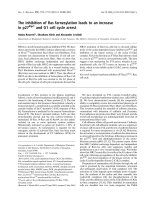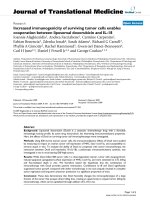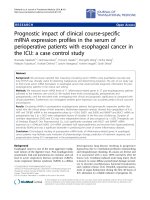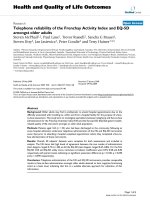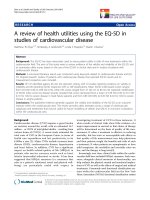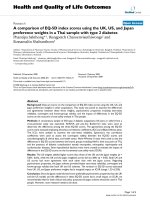Báo cáo hóa học: " Test-retest reliability of stride time variability while dual tasking in healthy and demented adults wit" ppt
Bạn đang xem bản rút gọn của tài liệu. Xem và tải ngay bản đầy đủ của tài liệu tại đây (208.77 KB, 5 trang )
SHORT REPOR T Open Access
Test-retest reliability of stride time variability
while dual tasking in healthy and demented
adults with frontotemporal degeneration
Olivier Beauchet
1*
, Ellen Freiberger
2
, Cedric Annweiler
1
, Reto W Kressig
3
, Francois R Herrmann
4
and Gilles Allali
5
Abstract
Background: Although test-retest reliability of mean values of spatio-temporal gait parameters has been assessed
for reliability while walking alone (i.e., single tasking), little is known about the test-retest reliab ility of stride time
variability (STV) while performing an attention demanding-task (i.e., dual tasking). The objective of this study was to
examine immediate test-retest reliability of STV while single and dual tasking in cognitively healthy older
individuals (CHI) and in demented patients with frontotemporal degeneration (FTD).
Methods: Based on a cross-sectional design, 69 community-dwelling CHI (mean age 75.5 ± 4.3; 43.5% women)
and 14 demented patients with FTD (mean age 65.7 ± 9.8 years; 6.7% women) walked alone (without performing
an additional task; i.e., single tasking) and while counting backward (CB) aloud starting from 50 (i.e., dual tas king).
Each subject completed two trials for all the testing condition s. The mean value and the coefficient of variation
(CoV) of stride time while walking alone and while CB at self-selected walking speed were measured using
GAITRite
®
and SMTEC
®
footswitch systems.
Results: ICC of mean value in CHI under both walking conditions were higher than ICC of demented patients with
FTD and indicated perfect reliability (ICC > 0.80). Reliability of mean value was better while single tasking than dual
tasking in CHI (ICC = 0.96 under single-task and ICC = 0.86 under dual-task), whereas it was the opposite in
demented patients (ICC = 0.65 under single-task and ICC = 0.81 under dual-task). ICC of CoV was slight to poor
whatever the group of participants and the walking condition (ICC < 0.20), except whil e dual tasking in demented
patients where it was fair (ICC = 0.34).
Conclusions: The immediate test-retest reliability of the mean value of stride time in single and dual tasking was
good in older CHI as well as in demented patients with FTD. In contrast, the variability of stride time was low in
both groups of participants.
Background
Stride time variability (STV), as measured by the coeffi-
cient of variation (CoV), is considered as a marker for the
control of limb-coordinated movements [1,2]. In terms of
gait control, a low variabilityofSTVwhilesteadystate
walking reflects an automatic process requiring minimal
attention, whereas a high variability is related to major
attention involvement [3]. Dual-task paradigms are u sed
by clinicians to evaluate the cortical involvement in gait
control [4]. Changes in gait performance while performing
an attention-demanding task compared to walking alone
result from interference caused by competing demands for
attention resources and depend in part on the efficiency of
executive functions [4-6].
Demented older adults demonstrate greater gait
impairme nts than those expected with normal aging pro-
cess [ 7,8]. In particular, frontal lobe dysfunction has been
associated with gait disorders in dementia [5,6,9]. Thus,
exploring gait v ariability under single and dual tasking in
demented patients with frontotemporal degeneration
(FTD) and in cognitively healthy individuals (CHI) might
improve our underst anding of higher-level gait disor ders
in dementia.
* Correspondence:
1
Department of Internal Medicine and Geriatrics, Angers University Hospital
(4 rue larrey), Angers (F-49933), Fra nce
Full list of author information is available at the end of the article
Beauchet et al. Journal of NeuroEngineering and Rehabilitation 2011, 8:37
/>JNER
JOURNAL OF NEUROENGINEERING
AND REHABILITATION
© 2011 Beauchet et al; licensee BioMed Central Ltd. This is an Open Access article distributed under the terms of the Creative
Commons Attribution License ( which permits unrestricted use, distribution, and
reproduction in any medium, provided the original work is properly cited.
Counting backward (CB) is an attention-demanding task
frequently used in dual task paradigm involving gait [4].
Compared with other attention-demanding tasks used in
dual-task paradigms involving gait, CB has been previously
associated with high gait changes in demented patients
with impaired executi ve functions [5,6,9]. For instance, it
has been reported that patients with Alzheimer’sdisease
(AD) or mixed dementia presenting with impaired execu-
tive functions exhibited an increase in STV during single
and dual tasking compared to non-demented counterparts
[5,9]. It has a lso been reported in a group of demented
patients with impaired executive functions that changes in
CoV of stride time while CB reflected the best dual-task
interference [6].
STV may be interpreted as surrogate marker for g ait
control only after it has been determined if dual-task-
related changes of STV are due to a pathologi cal process
affecting older adults, to a normal biological variability fol-
lowing consecutive gait measures from trial to trial or to a
measurement error. Although test-retest reliability of
mean values of spatio-temporal gait parameters has been
assessed for reliability while walking alone, little is known
on the test-retest reliability of gait variability while dual
tasking [10-12]. Recently, Hollman et al. showed in healthy
older adults that immediate test-retest reliability for varia-
bility in stride velocity was poor while dual tasking [11].
There is a lack of data for the test-retest reliability of STV
under single and dual-task conditi ons. The objective of
this study was to examine immediate test-retest reliability
of STV while single and dual tasking in CHI and in
demented patients with FTD.
Methods
Out of 80 community-dwelling CHI participating in a
large f all prevention program in Erlangen, Germany, 69
(90.0%) CHI (mean age 75.5 ± 4.3; 43.5% women) with at
least 3 consecutive measured gait cycles were included in
this study, with respect to the European guidelines for
clinical applications of spatio-temporal gait analysis in
older adults [13]. In addition, 14 consecutive demented
patients (mean age 65.7 ± 9.8 years; 6.7% women) with
FTD followed in a memory center in Paris, France, were
also included in the study. The selection of CHI has been
described elsewhere in details [14]. In summary, CHI
were drawn from a health insurance company member-
ship database. They were excluded if they were unable to
walk independently, were under 7 0 years of age or had
cognitive impairment. For the demented patients, diagno-
sis of FTD was based on the revised Lund and Manche-
ster criteria [15]. Dementia severity was measured with
the Mini-Mental State Examination (MMSE) [16] and
impairment in EF using t he Frontal Assessment Battery
(FAB) [17]. A FAB score of 18 indicates normal executive
functions. The mean duration of disease for FTD group
was 4.2 ± 1.9 years. Demented patients took 3.9 ± 2.5
drugs per day on average. T he mean MMSE score (/30)
and the mean FAB score (/18) were respectiveley 23.3 ±
6.6 and 12.6 ± 3.8. Exclusion criteria for FTD consisted
in extrapyramidal rigidity of the upper limbs with a score
above 2, based on item 22 of the Unified Parkinson’s Dis-
ease Rating Scale motor score (UPDRS)-motor score
[18]; acute medical illness in the past 3 months; neurolo-
gical and psychiatric diseases except dementia; severe
orthopaedic or rheumatologic conditions affecting nor-
mal walking, as well as use of walking aids. Written
informed consent was either obtained from the subject
or from their legal representative in case of cognitive
decline. The study was conducted in accordance with the
ethical standards set forth in the Helsinki Declaration
(1983). Each local ethics committee approved the project.
The mean value and the CoV (CoV = [standard devia-
tion/mean] × 100) of stride time while walking alone
(i.e., single tasking) and while counting backwa rd (CB)
aloud starting from 50 (i.e., dual ta sking) were collected.
Gait measurements were made according to the guide-
lines for clinical applications of spatio-temporal gait
analysis in older adults [13]. The mean value and the
CoV of str ide time were measured at self-selected walk-
ing speed and while stea dy state w alking using GAI-
TRite
®
and SMTEC
®
footswitches systems which are
two validated devices providing similar measures of
stride time [19]. The GAITRite
®
system is an electronic
walkway-integrated, pressure-sensitive electronic surface
connected to a person al portable computer via an inter-
face cable. The SMTEC
®
footswitches system is a pair
of innersoles fitted inside the subject’ s shoes. Each
innersol e contains 2 independent footswitches placed at
the heel and the toe, which are linked to a portable data
logger worn at the waist. To familiarize participants
using the SMTEC
®
system, each participant performed
one practice walk before recording.
The GAITRite
®
and the SMTEC
®
footswitches systems
used the same definition of stride time which was the time
elapsed between the first contacts of two consecutive foot-
falls of the same foot expressed in ms. Walking trials were
recorded on a 3. 5-meter walkway for GAITRite
®
and
10-meters walkway for SMTEC
®
. To assure measuring of
steady-state walking among CHI, participants started
walking 2 meters beforetheactivemeasuringelectronic
surface area and stop 2 meters after. In the group of
demented patients with FTD, stride time parameters were
collected on a 14-meter long walkway but were analyzed
only over a distance of 10 meters. The first and last 2
meters corresponding to the acceleration and deceleration
phase of each pass were excluded from analysis. All parti-
cipants were asked to perform the walking tasks without
prioritizing walking or cognitive task. Before testing, a
trained evaluator gave standardized verbal instructions
Beauchet et al. Journal of NeuroEngineering and Rehabilitation 2011, 8:37
/>Page 2 of 5
regarding the test procedure with a visual demonstration
of the walking test. Each subject completed two trials for
all the testing conditions. The walking trial was performed
in a well-lit environment. The participants walked at their
self-selected speed and wore their own footwear.
Immediate test-retest reliability of STV was evaluated
comparing the first and the second trial performed
while walking alone and while CB using intraclass corre-
lation coefficient (ICC). Separated analyses were used
for single and dual task condition. Using Landis and
Koch interpretation of agreement, an ICC > 0.80 indi-
cated almost perfect reliability, 0.61-0.80 substantial,
0.41-0.60 moderate, 0.21-0.40 fair, 0.00-0.20 slight,
below 0.0 poor [20]. P-values less than 0.05 were consid-
ered as statistically significant. All statistics were calcu-
lated using the Stata Statistical Software, version 11.1.
Results
All participants were able to complete single and dual-
task walking, without falling. As shown in Table 1, ICC
of mean value in CHI while single and dual tasking
were higher than ICC of demented patients with FTD
and indicated perfect reliability (ICC > 0.80). Reliability
of mean value was better while single tasking than dual
tasking in CHI (ICC = 0.96 under single-task and ICC =
0.86 under d ual-task), whereas i t was the opposite in
demented patients with FTD (ICC = 0.65 under single-
task and ICC = 0 .81 under dual-task). ICC of CoV was
slight to poor, whatever the group of participants and
the walking condition (ICC < 0.20), except while dual
tasking in demented patients where ICC was fair (ICC =
0.34).
Discussion
Our results showed that the immediate test-retest relia-
bility o f the mean value of stride time was perfect (i.e.,
ICC > 0.80), higher than the reliability of the CoV and
better in CHI than in demented patients with FTD. In
contrast, the reliability of the CoV was slight to poor in
both groups of participants, except while dual task ing in
the group of demented patients with FTD by whom it
was fair. In addition, the reliability of both stride para-
meters was bette r while dual tasking compared to single
tasking in demented patients with FTD but not in CHI.
The very good immediate test-retest reliability of
mean value of stride time while single tasking showed in
the studied sample of CHI and demented patients with
FTD is consistent with the literature. Indeed, previous
studies showed a high ICC for most temporo-spatial
gait parameters including stride time while walking
alone at usual walking speed [21-23]. Immediate test-
retest reliability of mean value of spatio-temporal gait
parameters while dual tasking has been few studied
compared to the single task condition. Our results high-
light a perfect reliability of the mean value (i.e., ICC >
80) while dual tasking based on Landis and Koch inter-
pretation of agreement [20] but under the reliability of
walking alone, except for demented patients. Like our
results, it has been recently shown that the ICC of the
mean value of velocity was slightly lower than the ICC
of mean value whi le single tasking in CHI [11]. In addi-
tion, we sh owed that ICC of the mean value of stride
time was better in CHI than in demented patients with
FTD. This result is also in concordance with the fact
that walking patterns of people with dementia are more
variable than those seen in normal ageing. This mainly
illustrates that, among demented patients, increased
variability occurs in both spatial and tem poral gait mea-
sures leading to lower immediate test-retest reliability
than found among CHI [7,8,12].
In contrast to the mean value, little is known abo ut
the test-retest reliability of stride-to-stride variability.
Our results show that the immediate reliability of the
CoV of stride time while single and dual tasking is poor,
which is in concordance with the few previous published
data. For instance, Hollman et al. recently reported
Table 1 Mean value and standard deviation of stride time parameters for two consecutively repeated trials while
walking alone awhile walking with counting backward among cognitively healthy individuals (n = 69) and demented
patients with frontotemporal dementia (n = 14)
Stride time
Mean value ICC Coefficient of variation ICC
Trial 1 Trial 2 Trial 1 Trial 2
Cognitively healthy individuals
Walking alone 1065.6 ± 105.3 1061.82 ± 104.0 0.96 1.3 ± 1.0 1.1 ± 0.8 -0.01
Walking with counting backward 1086.9 ± 183.5 1090.5 ± 225.1 0.86 1.7 ± 1.4 2.0 ± 3.3 0.11
Demented participants
Walking alone 1108.6 ± 90.2 1102.9 ± 83.4 0.65 5.0 ± 2.5 6.7 ± 4.6 -0.12
Walking with counting backward 1263.6 ± 124.5 1302.9 ± 131.2 0.81 7.6 ± 6.7 10.5 ± 9.3 0.34
±: Standard deviation.
ICC: Intra Class Coefficient Correlation
Beauchet et al. Journal of NeuroEngineering and Rehabilitation 2011, 8:37
/>Page 3 of 5
among healthy older adults that immediate test-retest
reliability fo r variability in stride velocity was poor while
dual tasking [11]. This low reliability of CoV of stride
time indicates that the measurement lacks of consis-
tency for immediate test retest. Poor measurement relia-
bility generally comes from three main sources which
are the innate random variability from trial to trial, the
gait speed, and/or a measurement error. Because of the
very good immediate test-retest reliability of the mean
value of stride time, the methodology we used (i.e., com-
puterized walkway) for measuring gait characteristics
and a measurement error may be excluded. Variation of
gait speed between trials could explain the low reliability
of CoV of stride time. Indeed, it has been shown that
one of the main factors influencing the STV is walking
speed [24-26]. An increase in gait speed has been asso-
ciated with an increase in stride time variability. The
fact that we found a good reliability of mean value o f
stride time ranging from perfect to substantial suggests
that participants, whatever their cognitive status, did not
vary their walking speed dramatically from one t rial to
another. Therefore, the modest reliability of gait varia-
bility measures cannot be attributed to true between-
trial changes in walking speed, but seem to be related to
innate random variability.
Whilst the reliability of CoV was slight to poor in
most case, our results highlight that the reliability while
dual tasking in demented patients with FTD was higher
compared to single tasking (ICC = 0.34 while walking
with CB versus ICC = -0.12 while walking alone) and
compared to CHI (ICC = 0.11). One explanation could
be a practice effect related to the repetition of trials. We
showed that demented patient s had a higher mean value
of CoV while dual tasking compared to CHI and com-
pared to walking alone, which is in concordance with
previously published data. We have earlier shown that
CB in demented participants with impaired EF provoked
severe perturbation in gait control resulting in an
increased CoV of stride time compared to the mean
value while dual tasking [5, 6,9]. Thus, the fact that
demented patients with FTD had a higher mean value
of CoV than in CHI suggest that they were disturbed by
CB as well durin g the first as the second gait trials with
no motor skill effect. We observed a similar effect with
the mean value of stride time.
The main l imitation of our study was the short length
of the walkway used to assess STV. The European GAI-
TRite network group recommends the highest number of
gait cycles possible from a practical standpoint, with a
minimum of three consecutive gait cycles [13]. Another
limitation could be in relation with the articulo-motor
components of enumerated figures which is different in
German and in French. However, it has been shown that
dual task-related stride time changes while CB in demen-
ted participants with fro ntal lobe dysfunction could not
be explained by the articulo-motor components of speech
[27].
Conclusions
Measurements of stride time variability had low
immediate test-retest reliability in older CHI as well as
in demented patients with FTD either in single or dual
task condition. In contrast, the reliability of the mean
value was good in both groups. This result suggests a
normal biological variability for stride time variability
between two immediate consecutive gait measurements.
Authors’ contributions
OB has full access to the data in the study and takes
responsibility for the integrity of the data and the accu-
racy of the data analyses; study concept and design: OB
and GA; acquisition of data: GA and EF; analysis and
interpretation of data: OB, GA, CA and FH; drafting of
the manuscript: OB, GA, C A and EF; critical revision of
the manuscript for important intellectual content: FH
and RK; obtained funding: not applicable; statistical
expertise: FH; administrative, technical, or material sup-
port: OB; study supervision: OB and GA.
Alltheauthors(OB,EF,CA,RWK,FRH,GA)have
participated in the research reported, have seen and
approved the final version of the manuscript, and have
agreed to be an author of the paper.
Funding
Gilles Allali was supported by a grant from the Swiss
National Science Foundation (No 33CM30-124115).
Author details
1
Department of Internal Medicine and Geriatrics, Angers University Hospital
(4 rue larrey), Angers (F-49933), Fra nce.
2
Institut fur Sportwissenschaft und
Sport, Friedrich-Alexander-Universitaet Erlangen-Nuernberg, (Gebbertstr.
123b), Erlangen (91058), Germany.
3
Department of Acute Geriatrics, Basel
University Hospital and University of Basel, (Spitalstrasse 21/Petersgraben 4),
Basel (4031), Switzerland.
4
Department of Rehabilitation and Geriatrics,
Geneva University Hospitals of Geneva, (12 chemin du pont bochet), Geneva
(1226), Switzerland.
5
Department of Neurology, Geneva University Hospital of
Geneva, (rue Micheli-du-Crest 24), Geneva (1205), Switzerland.
Competing interests
All authors have no conflicts of interest. There were not any financial and
personal relationships wit h other people or organization that could influence
this study.
Financial Disclosure(s)
No authors have relevant financial interest in this manuscript.
Received: 29 December 2010 Accepted: 11 July 2011
Published: 11 July 2011
References
1. Gabell A, Nayak US: The effect of age on variability in gait. J Gerontol
1984, 39:662-6.
Beauchet et al. Journal of NeuroEngineering and Rehabilitation 2011, 8:37
/>Page 4 of 5
2. Hausdorff JM: Gait dynamics, fractals and falls: finding meaning in the
stride-to-stride fluctuations of human walking. Hum Mov Sci 2007,
26:555-89.
3. Beauchet O, Allali G, Bridenbaugh S, Assal F, Kressig RW, Herrmann FR: Gait
variability among healthy adults: Low and high stride-to-stride variability
are both a reflection of gait stability. Gerontology 2009, 55:702-6.
4. Beauchet O, Annweiler C, Dubost V, Allali G, Kressig RW, Bridenbaugh S,
Berrut G, Assal F, Herrmann FR: Stops walking when talking: a predictor of
falls in older adults? Eur J Neurol 2009, 16:786-95.
5. Allali G, Dubois B, Assal F, Lallart E, de Souza LC, Bertoux M, Annweiler C,
Herrmann FR, Levy R, Beauchet O: Frontotemporal dementia: pathology
of gait? Mov Disord 2010, , 25: 723-9.
6. Allali G, Kressig RW, Assal F, Herrmann FR, Dubost V, Beauchet O: Changes
in gait while backward counting in demented older adults with frontal
lobe dysfunction. Gait Posture 2007, 26:572-6.
7. Alexander NB: Gait disorders in older adults. J Am Geriatr Soc 1996,
44:434-51.
8. Allan LM, Ballard CG, Burn DJ, Kenny RA: Prevalence and severity of gait
disorders in Alzheimer’s and non-Alzheimer’s dementias. J Am Geriatr Soc
2005, 53:1681-7.
9. Allali G, Assal F, Kressig RW, Dubost V, Herrmann FR, Beauchet O: Impact of
impaired executive function on gait stability. Dement Geriatr Cogn Disord
2008, 26:3.
10. Brach JS, Perera S, Studenski S, Newman AB: The reliability and validity of
measures of gait variability in community-dwelling older adults. Arch
Phys Med Rehabil 2008, 89:2293-6.
11. Hollman JH, Childs KB, McNeil ML, Mueller AC, Quilter CM, Youdas JW:
Number of strides required for reliable measurements of pace, rhythm
and variability parameters of gait during normal and dual task walking
in older individuals. Gait Posture 2010, 32:23-8.
12. Wittwer JE, Webster KE, Andrews PT, Menz HB: Test-retest reliability of
spatial and temporal gait parameters of people with Alzheimer’s
disease. Gait Posture 2008, 28:392-6.
13. Kressig RW, Beauchet O, European GAITRite Network Group: Guidelines for
clinical applications of spatio-temporal gait analysis in older adults.
Aging Clin Exp Res 2006, 18:174-6.
14. Freiberger E, Menz HB, Abu-Omar K, Rutten A: Preventing falls in
physically active community-dwelling older people: a comparison of two
intervention techniques. Gerontology 2007, 53:298-305.
15. The Lund and Manchester Groups:
Clinical and neuropathological criteria
for frontotemporal dementia. J Neurol Neurosurg Psychiatry 1994,
57:416-418.
16. Folstein MF, Folstein SE, McHugh PR: “Mini-Mental state”. A practical
method for grading the cognitive state of patients for the clinician. J
Psychiatr Res 1975, 12:189-98.
17. Dubois B, Slachevsky A, Litvan I, Pillon B: The FAB: a Frontal Assessment
Battery at bedside. Neurology 2000, 55:1621-6.
18. Ebersbach G, Baas H, Csoti I, Müngersdorf M, Deuschl G: Scales in
Parkinson’s Disease. J Neurol 2006, 253:iv32-5.
19. Beauchet O, Herrmann FR, Grandjean R, Dubost V, Allali G: Concurrent
validity of SMTEC footswitches system for the measurement of temporal
gait parameters. Gait Posture 2008, 27:156-9.
20. Landis JR, Koch GG: The measurement of observer agreement for
categorical data. Biometrics 1977, 33:159-74.
21. Menz HB, Latt MD, Tiedemann A, Mun San Kwan M, Lord SR: Reliability of
the GAITRite walkway system for the quantification of temporo-spatial
parameters of gait in young and older people. Gait Posture 2004, 20:20-5.
22. Bilney B, Morris M, Webster K: Concurrent related validity of the GAITRite
walkway system for quantification of the spatial and temporal
parameters of gait. Gait Posture 2003, 17:68-74.
23. McDonough AL, Batavia M, Chen FC, Kwon S, Ziai J: The validity and
reliability of the GAITRite system’s measurements: A preliminary
evaluation. Arch Phys Med Rehabil 2001, 82:419-25.
24. Beauchet O, Annweiler C, Lecordroch Y, Allali G, Dubost V, Herrmann FR,
Kressig RW: Walking speed-related changes in stride time variability:
effects of decreased speed. J Neuroeng Rehabil 2009, 6:32.
25. Dubost V, Annweiler C, Aminian K, Najafi B, Herrmann FR, Beauchet O:
Stride-to-stride variability while enumerating animal names among
healthy young adults: result of stride velocity or effect of attention-
demanding task? Gait Posture 2008, 27:138-43.
26. Beauchet O, Dubost V, Herrmann FR, Kressig RW: Stride-to-stride variability
while backward counting among healthy young adults. J Neuroeng
Rehabil 2005, 2:26.
27. Beauchet O, Dubost V, Aminian K, Gonthier R, Kressig RW: Dual-task-related
gait changes in the elderly: does the type of cognitive task matter? J
Mot Behav
2005, 37:259-64.
doi:10.1186/1743-0003-8-37
Cite this article as: Beauchet et al.: Test-retest reliability of stride time
variability while dual tasking in healthy and demented adults with
frontotemporal degeneration. Journal of NeuroEngineering and
Rehabilitation 2011 8:37.
Submit your next manuscript to BioMed Central
and take full advantage of:
• Convenient online submission
• Thorough peer review
• No space constraints or color figure charges
• Immediate publication on acceptance
• Inclusion in PubMed, CAS, Scopus and Google Scholar
• Research which is freely available for redistribution
Submit your manuscript at
www.biomedcentral.com/submit
Beauchet et al. Journal of NeuroEngineering and Rehabilitation 2011, 8:37
/>Page 5 of 5
